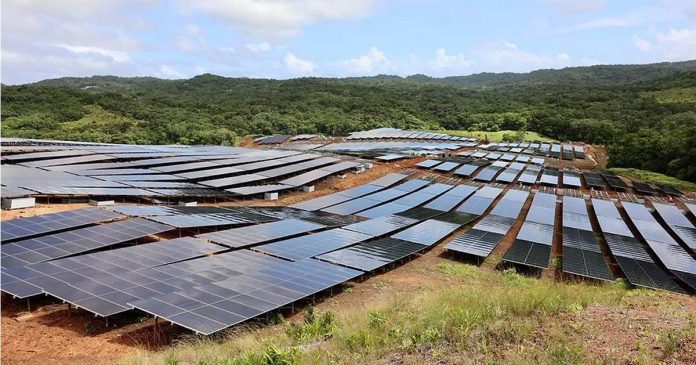Palau’s new solar power plant, commissioned in June last year serves as a benchmark for other Pacific Island Countries to seek clean energy funding support through public private partnerships (PPPs).
And, the Asian Development Bank (ADB) is excited that another northern Pacific nation has signed up to consider PPP financing for renewable energy project.
“ADB signed a mandate with the government of Federated States of Micronesia on 16 April 2024 to explore renewable energy options for its islands, said Cleo Kawawaki, the head of ADB’s Office of Markets Development and PPPs.
Kawawaki told PACNEWS the private-sector led solar project in Palau is the first-ever independent power producer (IPP) for the island nation.
With the support of the ADB, the Palau Public Utilities Corporation (PUC), undertook the largest solar power project in the Western Pacific – in its effort to support the government meet its national goal of 100% renewable energy by 2032.
Palau’s Public–private partnerships (PPP) model encouraged private sector involvement – with financing from three investors and financiers – the Export Finance Australia (US$18 million loan), the Department of Foreign Affairs and Trade Australia (US$4 million grant) and two private sector investors – Solar Pacific and Sant Charitable Foundation providing US$8 million equity
“The project invested US$30 million to supply 20% of Palau’s energy, (20–23 GWh per year) resulting in savings, a 15,310-ton reduction in greenhouse gases, and saving 5.6 million litres of diesel annually.”
“The investors and financiers invested all the money and fully undertook the performance risk of the Palau Public Utilities Corporation (PPUC) under the Power Purchase Agreement. This means government did not incur additional public debt, according to an ADB brief on the project.
Kawawaki said, “The PPP model was the most appropriate because it allowed government to provide public services in a critical area, using private sector funds and expertise, which were essential for the development of quality infrastructure and meeting its renewable energy targets.”
The project is a hybrid renewable energy system of 13MWac Photovoltaic (PV) and 10MW/13MWh Battery Energy Storage System (BESS) for 25-year operations.
Kawawaki said Palau was chosen because it was one of the countries in the Pacific that was behind in its renewable energy goal (<5% in 2019).
The senior ADB official said believes PPPs can develop the essential backbone infrastructure in Pacific Developing Member Countries (PMDCs).
“This would lead to more economic activities conducted by local firms and more foreign direct investments (FDIs) coming into Pacific DMCs. We are working on both the upstream policy development to enable private sector investment and midstream transaction advisory to bring bankable projects to the market for private sector to invest.”
Kawawaki revealed that renewable energy projects are the most bankable given the clear economic benefit of replacing diesel based power to renewable energy hybrid based power.
The ADB estimates that infrastructure requirements for the Asia Pacific region is over USD$1.7 trillion a year until at least 2030.
There is a huge gap between the financing that is required and what governments can afford to pay from their own budgets. This shortfall, along with weak capacity, an underdeveloped enabling environment, poor project preparation, and insufficient project financing, are holding back economic growth and poverty alleviation.
“Support from the private sector is needed at every stage of PPP development. In the upstream, governments can learn from private sector on how to plan, conceptualise, and structure PPP projects in a way transparent and fair to all stakeholders so that the projects would maximise value-for-money.
“In the midstream, inputs and feedback from the potential investors to the project’s design help the government structure the projects more attractive to private sector.
“At the development stage, capital expenditures would be provided by commercial investors and lenders. Construction activities would be carried out without major delay or cost overrun due to the operational efficiency private sector can bring in, explained Kawawaki.
“As the advisor of the PPP projects, ADB’s Office of Markets Development and Public-Private Partnership brings together perspectives and interests of various project stakeholders and enable them to take coherent approach for the common success. If we continue these efforts, the number and amount of PPP would grow and help to address the large infrastructure gap.”
The senior ADB executive admits the greatest challenge for Pacific developing member countries is attracting public private sector partnership is the small or non-existent private sector.
“The biggest challenge is small scale of market. There are other constraints also such as lack of capacity of government institutions, lack of enabling laws and regulations, lack of capacity of private sector and fragility of countries both from macroeconomic and climate change perspective.
“Another key bottleneck issue for the under-development of local private companies is lack of essential and fundamental infrastructure which keep cost of operations high. This is also the reason international firms have only limited interest to invest in local firms/business,” explained Kawawaki.














